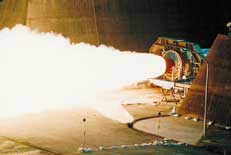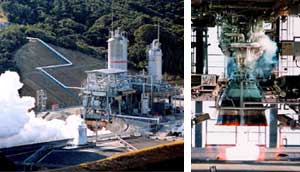 |
||||||
 H-IIA F6 was not the first Japanese launch vehicle to fail. Japan's
large-scale rocket development began with H-II, and progressed to H-IIA. H-II
F5 and H-II F8 failed due to problems with their liquid-fuel rocket engines.
That technology was first obtained from the United States. Later, Japan developed
H-II as its primary rocket system, and completed the evolution of liquid-fuel
technology with the transition to H-IIA.
H-IIA F6 was not the first Japanese launch vehicle to fail. Japan's
large-scale rocket development began with H-II, and progressed to H-IIA. H-II
F5 and H-II F8 failed due to problems with their liquid-fuel rocket engines.
That technology was first obtained from the United States. Later, Japan developed
H-II as its primary rocket system, and completed the evolution of liquid-fuel
technology with the transition to H-IIA.At the same time, since the launch of the Pencil Rocket in 1955, Japan's domestic rocket technology had focused on solid-fuel engines, and it was such an engine that caused the H-IIA F6 accident. Although that type of engine had previously been used in the H-I, M-V, and H-II launch vehicles, it had failed only once before, with M-V-4 in 2000. The M-V-4 accident happened near the beginning of the transition from H-II to H-IIA. At that time, H-IIA's engine design and development were considered to be complete, but the failure of M-V-4 clearly indicated an unfounded overconfidence in Japan's solid-rocket technology. That failure was followed by great efforts to make the whole system more sophisticated. We reduced the number of parts, improved reliability, and cut costs in half. H-IIA's rocket boosters became more compact and more powerful, ending up with a very different design from the H-II series. |
||||||
H-IIA's solid rocket boosters doubled the combustion pressure
of previous designs. To the three ground tests originally scheduled, two more
were added after the ablation of nozzle insulation proved to be greater than
expected. Once all five tests were completed, we concluded that the ablation
would not create a hole in the nozzle, that cause the failure, and thus finally
H-IIA F1 was launched. That was the first of five successful H-IIA launch vehicles,
and we believed that the technology had been validated. The F6 accident was
a rude shock. Studying its causes has reminded us of the difficulties of space
development. |
||||||
Almost all other types of technology - automobiles, aircraft, electrical appliances, etc. - can be thoroughly tested on the ground or in the air, where they are intended to be used. Rockets, on the other hand, are designed to go into space, and ground tests alone cannot prove their reliability. After all possible ground testing has been completed, the final - and most important - test is the actual launch. It costs a fortune to launch a rocket, so it's a fact of life that improvements have to be made based on a very limited number of launches. Some people might wonder why a satellite that costs billions of yen has to be launched under such uncertainty. However, for modern life, space infrastructure such as artificial satellites has already become an absolute necessity. No matter what the financial risk, we have to accept the uncertainty in order to continue to make progress. As long as we are capable of launching rockets, we should try to meet the needs of modern life. |
||||||
 |
With Japan's level of space technology today, it's as if we have
to stretch upward on our tiptoes to stand eye-to-eye with the rest of the space-faring
world. In order for Japan to be world-class with feet firmly planted, we must
gain more experience and develop more skills. In the lead-up to the H-IIA F6
accident, there was once again overconfidence in Japan's technology, and this
was probably one of the reasons the problem was overlooked. |
|||||
 |
||||||

